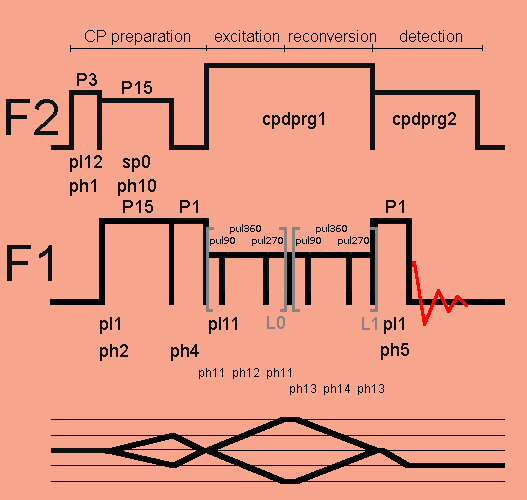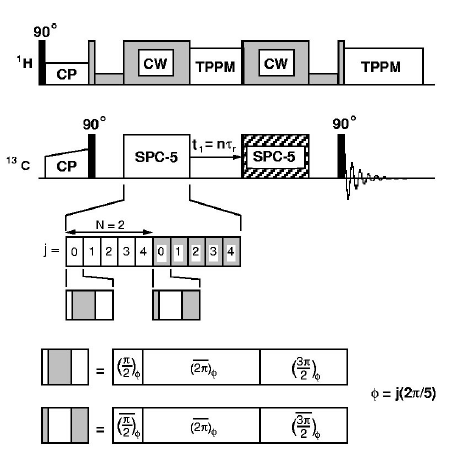
SPC5CP1d: 1D double quantum excitation 180°-phase shift supercycled POST-C5 CP pulse program for TopSpin2.1

SPC5CP1d: 1D double quantum excitation 180°-phase shift supercycled POST-C5 CP pulse program for TopSpin2.1

Since non-phase cycling is applied to the SPC5 excitation pulse, four-phase cycling is applied to the detection pulse P1 for selecting the 0Q -> -1Q coherence order jump, and four-phase cycling is applied to the SPC5 reconversion pulse for filtering DQ coherences.
Avoid cross-polarization during SPC5 excitation and reconversion.
;spc5cp1D (TopSpin 2.0) ;1D SQ-DQ correlation experiment with SPC5 sequence and cross polarization ;for the original C7 sequence see: Lee et al. Chem Phys Lett 242, 304-309, 1995 ;see Hohwy, Rienstra, Jaroniec and Griffin, JCP 110, 7983, 1999 ;Avance II+ version ;parameters: ;d1 : recycle delay ;p1 : excitation pulse f1 at pl1 ;p3 : 1H excitation pulse @ PL12 ;p5 : FSLG 2pi pulse set by lgcalc.incl ;p15 : HH contact pulse ;pcpd2 : decoupling pulse f2 @ PL12, pcpd2 = 2*P3-0.2us used by TPPM and SPINAL ;pcpd1 : decoupling pulse during SPC5 ;pl1 : for X contact pulse ;pl2 : =120dB, not used ;pl11 : for SPC5 recoupling sequence B1=5*cnst31 in Hz ;pl12 : for 1H excitation and decoupling ;pl13 : for LG decoupling cpdprg1 = cwlg or cw13 or tppm13 ;sp0 : proton power level during contact ;spnam0 : for CP on 1H e.g. ramp.64 ;cpdprg1: decoupling f2 during SPC5, e.g. cw (or cwlg) or tppm ;cpdprg2: decoupling f2, e.g. tppm15, SPINAL64 ;cnst20: LG-RF field as adjusted, in Hz used to calculate cnst22 and cnst23 +and - LG frequency ;cnst21: =0 frequency reset (set by lgclac.incl) ;cnst22: +LG frequency offset calc. by lgcalc.incl ;cnst23: -LG frequency offset calc. by lgcalc.incl ;cnst24: offset for 1H evol. during FSLG: 0 - -2000 ;cnst31: spinning speed ;l0 : number of composite SPC5 cycles in excitation multiple of 5 ;l1 : number of composite SPC5 cycles in reconversion multiple of 5 ;ns : 32*n ;$COMMENT=DQ excitation sequence SPC5, cp for excitation ;$CLASS=Solids ;$DIM=1D ;$TYPE=cross polarisation ;$SUBTYPE=homonuclear correlation ;$OWNER=Bruker define pulse pul360 "pul360=(1s/cnst31)/5" ;360° pulse define pulse pul90 "pul90=(0.25s/cnst31)/5" ; 90° pulse define pulse pul270 "pul270=(0.75s/cnst31)/5" ;270° pulse "d31=(1s/cnst31)" ;cnst11 : to adjust t=0 for acquisition, if digmod = baseopt "acqt0=1u*cnst11" #include <lgcalc.incl> ;calculates cnst22 from cnst20, RF field at pl13 #include <rot_prot.incl> ;protect for too slow rotation ze 1 10m 2 d1 do:f2 ;recycle delay, F2 decoupler off 1m rpp11 ;reset the phase ph11 pointer to the first element 1m rpp12 ;reset the phase ph12 pointer to the first element 1m rpp13 ;reset the phase ph13 pointer to the first element 1m rpp14 ;reset the phase ph14 pointer to the first element 1u fq=cnst21:f2 (p3 pl12 ph1):f2 ;proton 90° pulse (p15 pl1 ph2):f1 (p15:sp0 ph10):f2 ;contact pulse with square or ;ramp shape ramp.100 on F2 (p1 pl1 ph4):f1 ;90° pulse putting magnetization back to z-axis ;for SPC5 double-quantum excitation 1u pl11:f1 cpds1:f2 ;switch to SPC5 RF condition ;F2 decoupling during SPC5 cw (or cwlg) or tppm 3 (pul90 ph11 ipp13 ipp14):f1 ;SPC5 DQ excitation ;increment reconversion pulse phase ph13 and ph14 pointers (pul360 ph12 ipp12):f1 ;increment phase ph12 pointer (pul270 ph11 ipp11):f1 ;increment phase ph11 pointer lo to 3 times l0 ;l0 = multiple of 5 5 (pul90 ph13):f1 ;SPC5 DQ reconversion (pul360 ph14 ipp14):f1 ;increment phase ph14 pointer (pul270 ph13 ipp13):f1 ;increment phase ph13 pointer lo to 5 times l1 ;l1 = multiple of 5 (p1 pl1 ph5):f1 (1u do):f2 ;detection pulse, F2 decoupler off 1u cpds2:f2 ;F2 decoupling with TPPM or SPINAL during acquisition gosc ph31 ;gosc does not loop to 1 ;start ADC with ph31 signal routing 1m do:f2 ;F2 decoupling off ;DQ filtering (four phase cycling): 1m ip13*16384 ;increments all phases of ph13 by 90° 1m ip14*16384 ;increments all phases of ph14 by 90° lo to 1 times ns ;next scan 100m wr #0 ;save data on disk HaltAcqu, 1m exit ph1= 1 1 1 1 3 3 3 3 ph2= 0 ph4= 3 3 3 3 1 1 1 1 ph5= 0 0 0 0 0 0 0 0 2 2 2 2 2 2 2 2 1 1 1 1 1 1 1 1 3 3 3 3 3 3 3 3 ph10=0 ph11= (65536) 0 13107 26214 39322 52429 32768 45875 58982 6554 19661 ph12= (65536) 32768 45875 58982 6554 19661 0 13107 26214 39322 52429 ph13= (65536) 16384 29491 42598 55706 3277 49152 62259 9830 22937 36044 ph14= (65536) 49152 62259 9830 22937 36044 16384 29491 42598 55706 3277 ph31= 0 2 0 2 0 2 0 2 2 0 2 0 2 0 2 0 1 3 1 3 1 3 1 3 3 1 3 1 3 1 3 1

Definition of SPC5 excitation pulse.